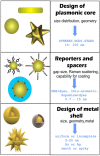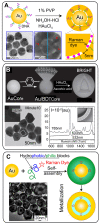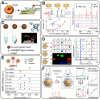Gap-enhanced Raman tags: fabrication, optical properties, and theranostic applications
- PMID: 32089735
- PMCID: PMC7019156
- DOI: 10.7150/thno.39968
Gap-enhanced Raman tags: fabrication, optical properties, and theranostic applications
Abstract
Gap-enhanced Raman tags (GERTs) are emerging probes of surface-enhanced Raman scattering (SERS) spectroscopy that have found promising analytical, bioimaging, and theranostic applications. Because of their internal location, Raman reporter molecules are protected from unwanted external environments and particle aggregation and demonstrate superior SERS responses owing to the strongly enhanced electromagnetic fields in the gaps between metal core-shell structures. In this review, we discuss recent progress in the synthesis, simulation, and experimental studies of the optical properties and biomedical applications of novel spherically symmetrical and anisotropic GERTs fabricated with common plasmonic metals-gold (Au) and silver (Ag). Our discussion is focused on the design and synthetic strategies that ensure the optimal parameters and highest enhancement factors of GERTs for sensing and theranostics. In particular, we consider various core-shell structures with build-in nanogaps to explain why they would benefit the plasmonic GERTs as a superior SERS tag and how this would help future research in clinical analytics and therapeutics.
Keywords: bioimaging; gap-enhanced Raman tags (GERTS); plasmonic core-shell nanoparticles; plasmonic photothermal therapy; surface-enhanced Raman scattering (SERS); theranostics.
© The author(s).
Conflict of interest statement
Competing Interests: The authors have declared that no competing interest exists.
Figures













Similar articles
-
Gap-enhance Raman tags (GERTs) competitive immunoassay based Raman imaging for the quantitative detection of trace florfenicol in milk.Food Chem. 2022 Oct 15;391:133233. doi: 10.1016/j.foodchem.2022.133233. Epub 2022 May 18. Food Chem. 2022. PMID: 35605538
-
Ultraphotostable Mesoporous Silica-Coated Gap-Enhanced Raman Tags (GERTs) for High-Speed Bioimaging.ACS Appl Mater Interfaces. 2017 Feb 1;9(4):3995-4005. doi: 10.1021/acsami.6b15170. Epub 2017 Jan 24. ACS Appl Mater Interfaces. 2017. PMID: 28074643
-
Ultrabright gap-enhanced Raman tags for high-speed bioimaging.Nat Commun. 2019 Aug 29;10(1):3905. doi: 10.1038/s41467-019-11829-y. Nat Commun. 2019. PMID: 31467266 Free PMC article.
-
Plasmonic silver and gold nanoparticles: shape- and structure-modulated plasmonic functionality for point-of-caring sensing, bio-imaging and medical therapy.Chem Soc Rev. 2024 Mar 18;53(6):2932-2971. doi: 10.1039/d3cs00793f. Chem Soc Rev. 2024. PMID: 38380656 Free PMC article. Review.
-
Plasmonic nanoparticle-based surface-enhanced Raman spectroscopy-guided photothermal therapy: emerging cancer theranostics.Nanomedicine (Lond). 2023 Mar;18(6):555-576. doi: 10.2217/nnm-2023-0010. Epub 2023 May 18. Nanomedicine (Lond). 2023. PMID: 37199287 Review.
Cited by
-
Recent advances in plasmonic Prussian blue-based SERS nanotags for biological application.Nanoscale Adv. 2021 Oct 21;3(23):6568-6579. doi: 10.1039/d1na00464f. eCollection 2021 Nov 24. Nanoscale Adv. 2021. PMID: 36132655 Free PMC article. Review.
-
Directed Assembly of Au Nanostar@Ag Satellite Nanostructures for SERS-Based Sensing of Hg2+ Ions.ACS Appl Nano Mater. 2023 Jun 5;6(12):10431-10440. doi: 10.1021/acsanm.3c01382. eCollection 2023 Jun 23. ACS Appl Nano Mater. 2023. PMID: 37384129 Free PMC article.
-
Raman Nanotags-Guided Intraoperative Sentinel Lymph Nodes Precise Location with Minimal Invasion.Adv Sci (Weinh). 2022 Jan;9(2):e2102405. doi: 10.1002/advs.202102405. Epub 2021 Nov 5. Adv Sci (Weinh). 2022. PMID: 34741446 Free PMC article.
-
Linker-Free Synthesis of Core/Satellite Nanoparticles for Single-Particle Surface-Enhanced Raman Spectroscopy and Photocatalysis.Nano Lett. 2025 May 14;25(19):7785-7792. doi: 10.1021/acs.nanolett.5c00763. Epub 2025 May 6. Nano Lett. 2025. PMID: 40326095
-
3D hierarchically porous magnetic molybdenum trioxide@gold nanospheres as a nanogap-enhanced Raman scattering biosensor for SARS-CoV-2.Nanoscale Adv. 2022 Jan 4;4(3):871-883. doi: 10.1039/d1na00746g. eCollection 2022 Feb 1. Nanoscale Adv. 2022. PMID: 36131829 Free PMC article.
References
-
- Le Ru EC, Etchegoin PG. Single-molecule surface-enhanced Raman spectroscopy. Annu Rev Phys Chem. 2012;63:65–87. - PubMed
-
- Fleischmann M, Hendra PJ, MsQuillan AJ. Raman spectra of pyridine absorbed at a silver electrode. Chem Phys Lett. 1974;26:163–66.
-
- Jeanmarie DL, Van Duyne RP. Surface Raman spectroelectrochemistry. Part 1: Heterocyclic, aromatic, and aliphatic amines adsorbed on the anodized silver electrode. J Electroanal Chem. 1977;84:1–20.
-
- Albrecht MG, Creighton JA. Anomalously intense Raman spectra of pyridine at a silver electrode. J Am Chem Soc. 1977;99:5215–17.
-
- Lim D-K, Jeon K-S, Hwang J-H, Kim H, Kwon S, Shu YD. et al. Highly uniform and reproducible surface-enhanced Raman scattering from DNA-tailorable nanoparticles with 1-nm interior gap. Nat Nano. 2011;6:452–60. - PubMed
Publication types
MeSH terms
Substances
LinkOut - more resources
Full Text Sources
Other Literature Sources
Medical
Miscellaneous

